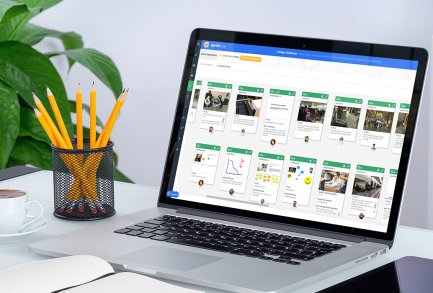13 things all great virtual facilitators do
With so many virtual meetings, workshops and webinars in people’s diaries right now, it’s more important than ever that the sessions you run are warm, welcoming, and fun to be part of.
We’ve shared our top tips for ways you can ensure your virtual ‘room’ is a place your participants want to be.
Take the time to greet everybody by name
It’s a simple thing, but taking the time to say hi to everybody by name as they join the call makes a huge difference. It’s so easy to feel unseen on a video call, but having the facilitator name them specifically will immediately make people feel part of the session and like their participation is valued.
Get everybody’s cameras switched on
You can’t read people you can’t see, and it’s hard to create any real bond when all you have to go on is a profile picture.
To make your virtual workshop as similar to an in-person experience as possible, you need to be able to see everybody, so ask people to switch their cameras on. Seeing other participants’ faces will enhance the session for your attendees too, as they’ll be better able to build a rapport with one another, and let you know when they have something to say.

Have no more than one person per square
If any of your participants are in the same room as one another, ask them to dial in separately. People are much more likely to engage properly if they have the screen to themselves, and it’s much easier for everybody else to see and interact with them if they’re not sharing their camera.
Agree how you’ll communicate as a group
There will be several moments during a session when you want people to let you know they’re following what you’re saying. So agree up front what kind of physical cue you want people to give you – such as a thumbs up or thumbs down – to confirm whether they’re with you.
And if people have a question or an issue, let them know how to tell you, whether it’s in the chat function or by raising their hand.
As the facilitator in a remote environment, you’ll need to make sure you pause more regularly than you might do in-person to ensure anybody with a query or comment has a chance to express it, as you won’t have the normal physical cues available to you.
Make everybody feel safe
Workshops work best when everybody commits to contributing from the start. One of the ways you can make sure that happens as the facilitator is by setting your virtual room up as a safe space.
If you’re running a session around design thinking and innovation, it should be clear that every thought, idea and curiosity is welcome and all part of the journey you’re going on anyway, but take the time to make sure everybody understands that.
Prepare people for action
To make sure you get the best out of everybody, any time you’re going to ask them to share their views, ideas or findings, let them know in advance. If you don’t prepare people for action, they’ll be so focused on feeling thrown by the sudden request that they won’t put all their effort into sharing the great things they’ve come up with.
To get people involved, be direct
When everybody’s in the same room, you can start conversations about the subject you’re covering by asking open questions and using people’s body language and expressions to spot people with something to say. But when you’re remote, it’s not that easy. People might feel too nervous to jump in or unsure about when it’s their turn to speak. It’s very easy to accidentally interrupt one another on a video call, and it can put people off trying.
So to get around this and to get a conversation going, ask people direct questions instead of open ones.
This isn’t about catching people out or embarrassing anybody – and if people really don’t feel like sharing, of course they don’t have to – but it’s a way to help you ensure everybody has a chance to have their say.
Manage your most enthusiastic participants gently
Whilst some people can feel shy in a workshop, others might be so engaged and enthusiastic that they end up dominating the conversation. As the facilitator, it’s your job to manage the situation so that such people feel heard and that their contributions are valued, but also to enable less forthcoming attendees to speak up too.
Again, this is where using people’s names to indicate who you want to hear from will help you manage the room and make everybody feel included. If you find yourself with any real over-talkers, a gentle, direct acknowledgement of their energy and request for space for others to share their thoughts should help them see the need to step back a little.
Mix it up with frequent, varied activities
If you find that you’ve been speaking for more than 5-10 minutes at a time, you’ve been speaking for way too long. To keep people engaged and motivated, you should give them something new to do as frequently as possible. Whether it’s just a quick question, multiple choice poll, or something as involved as an icebreaker or breakout room discussion, frequent, varied and inclusive activity will maintain everybody’s energy and reduce the risk of ‘Zoom-drift’.
Develop an approach to joining breakout rooms
You might want to drop in on teams in breakout rooms to see how they’re getting on, but it can feel intrusive to show up unannounced. So establish an approach to visiting. Let everybody know that you’ll be circulating so they know to expect you, and that, a lot of the time, you’ll just be there to listen. If you want to interject or help people work through a problem, make yourself known first to avoid interrupting.

Schedule regular breaks
Just as you would with an in-person event, make sure you have regular breaks throughout your session and that people know when they’re going to be. It’s easier to focus when you know there’s a scheduled pause around the corner. Set a timer so everybody knows how long they have and when you’ll be starting again.
Help people find the answers for themselves
As the facilitator, it’s your job to facilitate a session and conversations that take people somewhere. It’s not your job to know all the answers, but to help the group find them together.
So when somebody asks you a question about the challenge you’re working through, an insight, or an idea, don’t be afraid to throw it back to the ‘room’ (being specific about where you direct it, as mentioned above). Thank the person for their question, and then see what others have to say to help answer it.
Stay positive and optimistic
At any point during your session, it’s you that sets the tone. So keep an optimistic mindset and find your perfect balance between pushing the team to do the best they can, and encouraging them to acknowledge and celebrate how far they’ve come. Your approach will be key to keeping everybody motivated and moving forward.
And when things do go wrong – which they always do at some point – don’t let it bring you down. Everybody knows that technology fails us sometimes. There will also be moments when your group is silent and not giving you anything. Whatever you do, don’t criticise them for not participating, just stay positive and focused on what you’re doing and everybody will come with you.
Want to take your remote facilitation skills to the next level in 2021? Want to make the workshops, projects and experiences you run even more amazing – and to get all the training, materials and Sprintbase access you need to do it? Join us for our March Remote Design Skills Essentials course, happening from 29 – 21 March. Find out more.
More from the blog

8 cool things you can do on Sprintbase
We love using your feedback to make your journey better, and to help you achieve even more amazing results.

Great icebreakers: How to kick off a virtual workshop
Whatever kind of design thinking workshop you’re running – whether in-person or virtual – it’s so important to take a few moments before you kick off to get your participants warmed up, comfortable with one…

How to be a great virtual workshop facilitator
Pretty much every meeting, workshop and conference on the planet is being done virtually right now. But what does it take to be a great virtual facilitator?
Get a free trial
Contact us to get your free trial or to talk about how Sprintbase can help you achieve your remote innovation goals.
Get started





